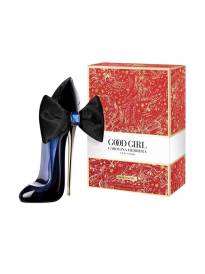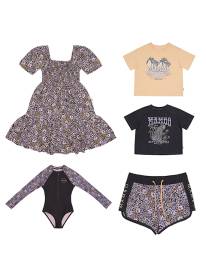Zoe Margaret Scary Stories To Tell In The Dark
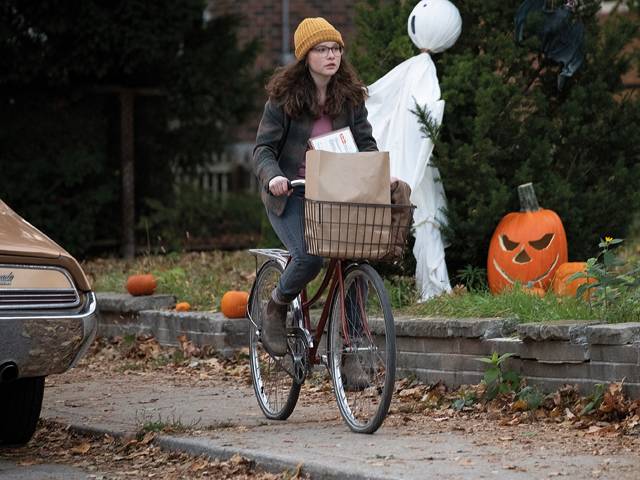
A group of teens face their fears in order to save their lives.
Cast: Javier Botet, Dean Norris, Austin Abrams, Gil Bellows, Zoe Margaret Colletti, Austin Zajur, Michael Garza, Natalie Ganzhorn, Gabriel Rush
Director: André Øvredal
Genre: Horror
Running Time: 107 minutes
Synopsis: It's l968 in America. Change is blowing in the wind...but seemingly far removed from the unrest in the cities is the small town of Mill Valley where for generations, the shadow of the Bellows family has loomed large. It is in their mansion on the edge of town that Sarah, a young girl with horrible secrets, turned her tortured life into a series of scary stories, written in a book that has transcended time"stories that have a way of becoming all too real for a group of teenagers who discover Sarah's terrifying home.
Scary Stories To Tell In The Dark
Release Date: September 26th, 2019
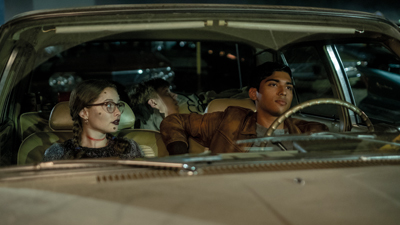 About The Production
About The Production
"Stories heal. Stories hurt. If we repeat them often enough, they become real." Throughout time immortal there have existed stories so powerful they can shoot tingles up the spine, steal the breath, darken the night, turn flesh to prickly goosebumps, and in American folklore, these shadowy tales have been told and retold around campfires, at drive children (not to mention adults) safely under the blankets. Long embedded sleepovers, in schoolyards, between friends and among families for the sheer bone-chilling fun of it all. But what if…what if the most startling legends of supernatural horror, revenge and the ghostly macabre suddenly became your actual reality?
That's what happens in Scary Stories to Tell In The Dark, a horror tale drawn from the iconic but deeply eerie book series by Alvin Schwartz. As brought to life by the visionary team of producer Guillermo Del Toro (The Shape of Water, Pacifc Rim, Pan's Labyrinth) and director André Øvredal (Trollhunter), the film is anything but an anthology. Instead it's a tale of a group of young misfits who must confront all the fears that stand between them and the future.
It all begins in 1968. In a time of turmoil, things remain relatively sleepy in Mill Valley. That is until outcast teenagers Stella, Ramon, Chuck and Auggie dare to explore their town's infamously creepy haunted house"the cobwebbed former home of the reportedly murderous Sarah Bellows"and discover within a book that proves to have colossal supernatural powers. Almost immediately, the book changes their fates. One by one, they find themselves living out the stories Sarah chooses to tell…Harold, The Big Toe, The Red Spot and more… as each is inexorably summoned to do battle with their own most uniquely terrifying dreads.
"We wanted to recreate some of the most cherished, scary, fun and entertaining horror tales that are found in Alvin Schwartz's books. But we do it in a way that is seamless within one story about a group of friends in the 1960s," explains Del Toro, who has explored the power of horror to move, thrill and illuminate throughout his Oscar®-winning filmmaking career.
Often dubbed "king of the monsters," Del Toro has long pursued the heights of invention and emotion dark tales inspire. He so adored the Scary Stories books that he bought several Gammell sketches decades ago. Now, he relished the chance to create something fresh with them. "The beauty of these stories is that they have the eternal appeal of campfire tales that invite people to shiver together in anticipation, even when you hear them again and again," says Del Toro, "In our movie, we add to the fun of that themes of friendship, belief, compassion, and the idea that stories can damage, or they can heal."
Del Toro continues: "There are two types of horror movies. First are the ones that sort of scar your soul. But then there is the horror movie that is like a roller coaster ride. It's fun, entertaining and thrilling but ultimately has a humanistic spirit. And that's the type of movie André has made"one where you have fun getting scared."
For Øvredal, Scary Stories was not only a chance to take on his biggest film to date. It was equally a much-desired opportunity to pay homage to those wonder-inducing, kids-on-admission movies that formed his own cinematic education. He was drawn to making a PG-13 horror movie that would reach a wide age-range of people fascinated by the creepy.
"I approached Scary Stories to Tell in the Dark as a mix between a horror tale and an ode to the Amblin adventures I loved growing up," Øvredal explains. "So, you have these very grounded, funny, real characters battling evil forces from the realms of fables and monsters. I wanted to try to balance the energy and adrenaline you get from horror with the positive vibes I found in the Hollywood adventures that made me fall in love with movies as a kid."
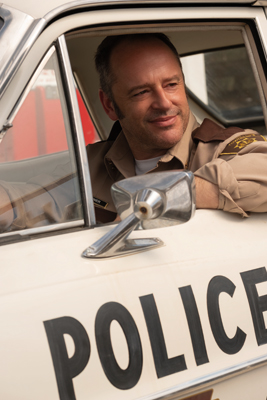 While the flm is bursting at the frames with bloodcurdling creatures and nightmares come to life (but no gore), Øvredal notes it is equally about the real anxieties of growing up in a challenging world. A human element drives the action from the start. This comes to the fore as Stella and friends discover the notorious Sarah Bellows may not have been the psychopathic monster that they were led to believe by town myths. Now, righting the wrongs committed against this outsider not so different from them becomes their one hope of surviving the stories she's concocting in revenge.
While the flm is bursting at the frames with bloodcurdling creatures and nightmares come to life (but no gore), Øvredal notes it is equally about the real anxieties of growing up in a challenging world. A human element drives the action from the start. This comes to the fore as Stella and friends discover the notorious Sarah Bellows may not have been the psychopathic monster that they were led to believe by town myths. Now, righting the wrongs committed against this outsider not so different from them becomes their one hope of surviving the stories she's concocting in revenge.
"We had fun creating the monsters on screen, but the worst monsters in this movie are lies, deceit and untrue stories," Øvredal sums up. "That's what starts the story's cycle of fear."
The Frightening Book
Urban folklore, campfire tales and accounts of the chillingly inexplicable suddenly disrupting ordinary life have left children and teens cheerfully terrified for centuries. They have long been a rite-of-passage as kids develop the confidence, and even the to cope with intense situations. But it was in the early 1980s that author and journalist Alvin need, to face off with their fears, to draw the lines between good and evil and discover how Schwartz actually collected some of these nightmarish legends from old anthologies, magazines and folklorists in a series of books that would become a runaway phenomenon.
His Scary Stories To Tell In The Dark was such a hit, it was soon followed by More Scary Stories To Tell In The Dark and then Scary Stories 3: More Stores to Chill Your Bones. Originally illustrated by Caldecott Medal-winning artist Stephen Gammell, the stories came to life not only in words but in wildly surreal, unapologetically hideous ink drawings that seemed to leap from the pages straight into the imagination, where they lingered.
Though Schwartz passed away in 1992, Scary Stories To Tell In The Dark became one of the most-loved book series of the 90s, selling millions of copies on its way to becoming a cultural touchstone for an entire generation. The passion for the books even sparked a controversial movement to ban them from school libraries. Yet, it seemed that the harder the books were to fnd, the more and more their popularity swelled. As Del Toro puts it, "the banned books became catnip for adventurous youth."
Perhaps what kids loved most about them is that these stories didn't hold back. They were genuinely designed to press all your buttons and bring all your wildest fears into the light. The frst time you read them was a bone chilling blast. But you could read them again and again and the scares stayed fresh.
For Guillermo Del Toro"who has always seen monsters as metaphors for what humans try their best to hide away and who believes scary stories are vital to children's forming psyches"the Scary Stories books were ironically a source of pure joy. When he heard that CBS Films had acquired the rights, he immediately wanted to join in on the creation.
"This was a chance to honor the book by telling a bigger story that would be very scary but also full of the playful spirit of youth," says Del Toro. "It was also a chance to look at the weight and responsibility of storytelling, so relevant in our world of social media today."
Producer J. Miles Dale, who worked with Del Toro on his acclaimed The Shape of Water, had already had his own personal encounter with the potency of the stories. "My son read them," Dale recalls. "My wife had bought them, and I remember looking at them thinking 'this is not bedtime reading.' But it turns out that a lot of people found these stories to be formative in their childhoods, so it felt like fertile ground for Guillermo."
Del Toro started with the idea of the supernatural book that writes itself"and shifts reality in the process. "The book basically customizes a story before your eyes to tap into fears of the person reading it," Del Toro explains. "This give you the delicious thrill of seeing a story coming for each character you've gotten to know and then bracing yourself in preparation."
He also knew he wanted a retro vibe for the story. But rather than going back to the 80s setting of so many teen adventures, he kept going, all the way back to 1968, as American soldiers battled in Vietnam and protests erupted at home. In a presidential election year that involved assassinations, riots and cultural upheaval, a growing sense of profound national division and change was even beginning to hit remote towns like Mill Valley.
For Del Toro, 1968 allowed for a world without any hint of mobile phones or the internet, where life was truly local, and you definitely couldn't post your weird experiences on Instagram. But also, the time period felt catalytic. "The whole ideal of the American Dream and American innocence was shifting as the world became much more complex, and scary in new ways," describes Del Toro. "The Vietnam War itself is sort of a ghost that looms over the town. It's a very unstable time for these kids to undergo this extreme rite of passage."
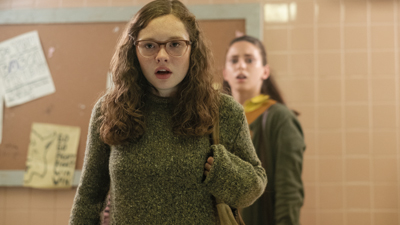 To color in the outlines of his story with deeply inviting characters, Del Toro turned to the screenwriting duo of Dan & Kevin Hageman. Known for their work on the boisterously imaginative LEGO Movie, they had just collaborated with Del Toro on the Netflix series Trollhunters. He liked the idea of their joyful, high-energy style counterpointing the dark allure of Schwartz's scary legends. The Hagemans, in turn, couldn't wait to tackle their first scary movie.
To color in the outlines of his story with deeply inviting characters, Del Toro turned to the screenwriting duo of Dan & Kevin Hageman. Known for their work on the boisterously imaginative LEGO Movie, they had just collaborated with Del Toro on the Netflix series Trollhunters. He liked the idea of their joyful, high-energy style counterpointing the dark allure of Schwartz's scary legends. The Hagemans, in turn, couldn't wait to tackle their first scary movie.
"We'd never before read the books because I think they were banned at our school," muses Dan Hageman. "But when Guillermo pitched us this story, we absolutely leapt at the idea of it. We've always wanted to write a real coming-of-age adventure and this finally gave us a chance to do that while mixing in these truly frightening scares that people of all ages love."
Adds Kevin Hageman: "From the start, Guillermo made it clear that while he wanted the visuals to follow in the style of Gammell, he wanted the film's heart to be founded on the characters, on three-dimensional, real friends who you care about and relate to, which makes the ride that much more frightening. That's what really excited us"because those are the kinds of films we've always loved most: the kind where you have more than one feeling, where you're thrilled and scared but then maybe also amused, romanced and moved."
Their first task was simultaneously exhilarating and tough: choosing which handful of stories from the books they would tie into the narrative. "Guillermo told us go get the books and read everything," remembers Kevin. "Then we all got together for dinner and shared which stories really jumped out at us individually. It turned out all three of us loved a lot of the same stories that the fans do. Of course, there were lot of stories we all enjoyed that we couldn't put in this flm, but we also added plenty of Easter eggs that fans of the books will recognise."
Each of the main stories were adapted to link up with the film's four central friends and their own personal journeys and anxieties. "While the stories are very much recognizable from the book, we also put some twists into each of the stories to keep the audience on their toes," Dan explains. "So, even if you've read the books you don't know exactly what's coming. A lot of the stories also end very abruptly which is spooky on the page, but we needed to fnd ways to weave their endings back into the lives of our characters without disrupting the action."
As they got deeper into the writing, the Hagemans couldn't help but ask each other what makes adolescents crave scary tales with a passion. "We talked a lot about how we all remember those stories that scared us the most for the rest of our lives," says Dan. "They leave a mark on you, but I think in a good way, because you realize that it's OK to be frightened and overwhelmed with emotions at times. That's the essence of coming of age: figuring out all the things people have to overcome to function in the real world. But with stories, you get to face your fears first within the safety of a book or a flm."
The Hagemans also poured over all their favorite spooky movies, from Poltergeist to The Ring, in preparation. But they eschewed all blood and gore, following Del Toro's lead in taking a purer psychological approach. "Gore isn't necessary to create something absolutely terrifying," notes Kevin. "But we still wanted to make it as scary as you can push a PG-13 movie."
When it came to the characters, the Hagemans decided to make the inquisitive, lonely Stella the lead role. "I think what we loved about Stella being the lead is that she's the mirror of our villain Sarah Bellows in so many ways. They're both outsiders, and Stella feels compassion for Sarah. We loved having some heart in the middle of a horror tale," says Kevin. Dan adds: "With each of the characters, we wanted you to really root for them and to understand what they mean to each other so that the stakes are really, really high."
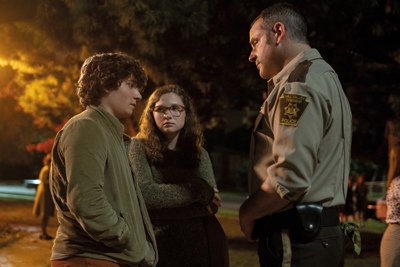 The legend of Sarah Bellows was inspired by a single sentence Del Toro uttered, which became the hinge of the entire film: stories can hurt, and stories can heal. "That idea inspired us to write Sarah as a woman who is harmed by stories that are malicious, stories that are lies, stories that drive her to become the monster people say she is," says Kevin.
The legend of Sarah Bellows was inspired by a single sentence Del Toro uttered, which became the hinge of the entire film: stories can hurt, and stories can heal. "That idea inspired us to write Sarah as a woman who is harmed by stories that are malicious, stories that are lies, stories that drive her to become the monster people say she is," says Kevin.
The direction of the characters, notably the kids, gratified Del Toro. "These characters are real kids whose lives, like most of our lives, are messy. They're dealing with problems at school, problems at home and fears of the future as they become adults," says Del Toro. "Feeling fear is natural; vanquishing it is extraordinary. And these kids have to be extraordinary to make it through the tests they face."
The Exuberantly Eerie Director
All along, Del Toro was in search of a director who was ready and willing to play freely in Scary Stories To Tell In The Dark was destined to provide. He found exactly that in the Norwegian flmmaker André Øvredal. Øvredal came to the creative sandbox that fore with his darkly hilarious "found footage" mockumentary Trollhunter, in which three student filmmakers discover a man who claims to have the perilous job of government troll slayer. The film's originality and deadpan humor took critics and audiences by surprise. Øvredal followed that with the more frightening supernatural thriller The Autopsy of Jane Doe about father-grandson coroners who uncover a gruesome mystery,
The appeal of Øvredal to Del Toro was simple: "André has a great sense of character, a great sense of humor, a great sense of pacing, and he makes very scary movies."
For Øvredal, receiving the script was the start of his own fantastic adventure. "I was not familiar with the Scary Stories books before," he admits, "so learning about them started me on the very joyful experience to get to know this incredible world of Alvin Schwartz and Stephen Gammell." The chance to work with Del Toro in this realm of monsters that they are both drawn to so passionately was also something Øvredal won't soon forget. "Guillermo is a master storyteller that I've learned so much from," he says. "Just his understanding of how to tell a story on screen, not to mention his brilliance with creating stunning creatures, was crucial to doing this film. He has an acute sense of how to heighten everything he touches."
A deep rapport opened up between Del Toro and Øvredal, says producer Dale. "When Guillermo produces, he is very supportive and brings in a lot of ideas, but he also really wants the director to be able to put their own fingerprints on the movie. Luckily, André is also a very visual guy, so, he and Guillermo spoke that language with each other. They were constantly talking about things like palette and camera style in a very detailed way."
Much as the film's monstrosities intrigued, Øvredal was most excited about bringing the tightknit circle of friends who encounter them to life.
"I liked the idea of creating a group of friends who each come from really distinct and different backgrounds," Øvredal explains. "You have Stella who has always felt like an outsider in the town and is struggling with her relationship with her father. You have Ramon who is a Mexican American passing through town with his own secrets. Then there's Auggie who has a more upper scale life but has issues with his controlling mother. Finally, you have the brother and sister Chuck and Ruth, with Ruth being the story's one cool girl and Chuck being an energetic, fun character with a goofy sense of humor."
Then there was Sarah Bellows, still in search of a reckoning. Øvredal found her compelling. "Sarah Bellows was a girl who grew up as the black sheep of a very rich family. She should have had it all, only her family thought of her as different and treated her horrifically because of that," Øvredal describes. "She basically was confined to a small room and that is why she started inventing stories. Eventually she would become a scapegoat, which spurred her to seek vengeance through fear."
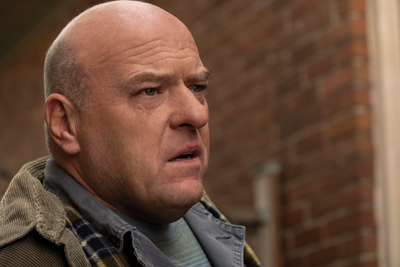 In taking on Scary Stories, Øvredal knew he faced the considerable responsibility of bringing the chills associated with the books. He describes his approach to scaring audiences as "suspension-based horror."
In taking on Scary Stories, Øvredal knew he faced the considerable responsibility of bringing the chills associated with the books. He describes his approach to scaring audiences as "suspension-based horror."
"I like to build dread slowly," he explains. "I like to let the audience know something's coming and build the tension that way and then hold them hostage to that tension for as many minutes as I can," he chuckles. "Ultimately a lot goes into building that tension: the performances, the photography, the design, the editing, the music and of course the sound, too. But it all has to add up to dread."
The Curious Teens
Stella:
The stories of Scary Stories To Tell In The Dark come hurtling into the world of five small feisty, and a lover of stories in her own right, but trying to find her place and her strength having town teens, bringing to life each of their deepest fears. The misfit loner who unwittingly takes possession of Sarah Bellows' dangerous book is Stella Nichols, who is smart and grown up in a troubled home.
Notes J. Miles Dale: "There are parallels between Stella and Sarah Bellows that you increasingly become aware of as the story unfolds. They both embody the theme of the movie that stories can hurt, and stories can heal"and in Stella's case she tries to find a way to make the stories that hurt become stories that heal."
Taking the role is Zoe Margaret Colletti who came to the fore in the 2014 screen adaptation of Annie, was recently seen in Wildlife with Jake Gyllenhaal and Carrie Mulligan, and currently stars in Showtime's City On a Hill. She can currently be seen in theaters in A24's Skin opposite Jamie Bell and Danielle Macdonald.
Colletti had never read a single story in the Alvin Schwartz books when she first heard about the project, but her curiosity was piqued. "A lot of people freaked out when I mentioned I was auditioning for Scary Stories To Tell In The Dark, so I knew I had to start reading them," she explains. "And, oh my, they were so awesome and so scary and there was such a unique tone about them."
When she read the script, she was even more excited to see how the stories were woven into a teen odyssey that captured the wonders of friendship as much as the horror of gruesome creatures coming out of the woodwork. "I loved the dynamic between these four friends and how unique each character is," Colletti says. "I think when you're watching people who seem so personable and relatable that makes the monsters feel even more crazy real."
As for Stella, Colletti immediately felt a bond. "She's an unusual teen character, because she's an introverted person in a very dark place. Her mother is not really in the picture and she has a tough time connecting with her father. What I like most about her is that she's someone who feels alone instead of being this popular teen with 30 million friends having the time of her life. It's a nod to the reality that high school can be really tough for a lot of people."
When Stella meets an outsider passing through town, the kind and alluring Ramon, everything changes. "Stella and Ramon fnd this mutual connection they've both been waiting a long time for," says Colletti.
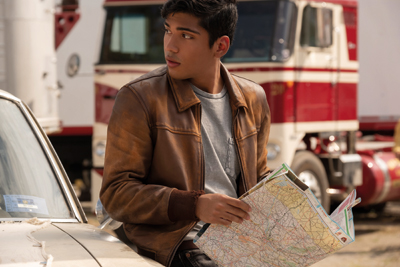 They also find Sarah Bellows' book, not realizing what it holds in store for both of them, not to mention all of Stella's friends. "That book causes a lot of trouble!" laughs Colletti. "It winds up connecting the stories that Sarah Bellows was writing a century ago directly to our characters' lives in 1968."
They also find Sarah Bellows' book, not realizing what it holds in store for both of them, not to mention all of Stella's friends. "That book causes a lot of trouble!" laughs Colletti. "It winds up connecting the stories that Sarah Bellows was writing a century ago directly to our characters' lives in 1968."
As Stella watches the book unravel the lives of those around her, she increasingly comes face-to-face with her own greatest fear: hurting those she loves. "It gives Stella a certain power
having the book, but it's scary power, especially for someone who has felt powerless her whole life," Colletti observes. "She comes to fear what she is bringing into the lives of the people she cares about."
Ramon:
To Ramon Morales, Mill Valley is supposed to be nothing more than a stop on the road, the ancient past. Taking the key role is 19-year-old Texan native Michael Garza, who has until he meets Stella and gets drawn into an epic battle against macabre forces from been seen in The Hunger Games: Mockingjay Part 1.
Already a fan of Stephen Gammell's art, for Garza that was a big part of the draw. "Gammell knows just how to terrify you on the page, so the chance for us all to try to bring that to life on screen I thought was awesome," he says. "I also really like how the script mixes the fantastical elements with things all teenagers go through."
As a classic outsider drawn into a town's mystery, Ramon intrigued Garza. "He's just passing through and he is not looking to stay long in Mill Valley until he meets Stella," Garza explains. "I think he and Stella are kind of kindred spirits. They're both feeling alone and a little lost and they find comfort in each other."
Ramon is accustomed to not fitting in, but with Stella, he can fully be himself. "As a Mexican American, Ramon has become used to being looked down upon or as dangerous," notes Garza,
"but Stella sees him for who he is. So that's why he stays in Mill Valley. He has his own big worries for the future with the Vietnam War going on"but little does he know he's going to get drawn into such a scary situation in this small town."
Sarah Bellows taps into Ramon's biggest fear: the fear of not doing the right thing. "Ramon fears fghting for something he doesn't ultimately believe in, which is something that becomes very important to his storyline," explains Garza.
Garza, however, has a different phobia from Ramon. "For me, it's spiders," he says. "Anything having to do with spiders is super freaky for me, so I was most definitely dreading shooting The Red Spot story!"
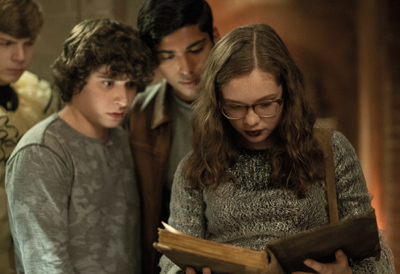 Auggie:
Auggie:
Brainy, nerdy but sweet Auggie Hilderbrandt is the frst of the close circle of friends to be targeted by Sarah Bellows' book of stories"on the heels of the town bully, Tommy, disappearing. Playing Auggie is rising star Gabriel Rush, who has already appeared in two films for director Wes Anderson: Moonrise Kingdom and The Grand Budapest Hotel.
Rush loved the way the script entwined the scary stories into a bigger adventure of four friends battling to save one another. "These urban legends were written to be told so it's really interesting what the script did with the book that writes itself and causes each story to start happening in real life," says Rush. "I think fans are going to be so excited to see these illustrations that scared them in the books come to life in this way."
The 1960s time period also intrigued Rush. "The really big difference back then was just the speed of communication," he observes. "Now, if you were presented with some of the situations in the film, you'd just Google to find out what kind of crazy stuff you might dealing with! But in 1968, you had to find out the answers for yourself, and maybe you had to get on a bus and go to an old mental asylum searching for records. The period makes it more fun."
Like his friends, Auggie doesn't quite fit in, being an avid reader who lives in his mind, and has hidden struggles at home. "Auggie is an only child and his parents are divorced, so really his friendship with Chuck and Stella is the only source of stability in his life," Rush notes.
Rush especially enjoyed Auggie's camaraderie with Chuck, played by Austin Zajur. "They have a fun and hilarious relationship that felt very realistic," Rush describes. "They're both always trying to get each other's goat"but that is also the glue that binds them. And I just loved working with Austin, so I hope that translates on the screen."
Adds producer Dale: "Auggie and Chuck are kind of like Laurel and Hardy, or Dean and Jerry, that kind of comedic pairing where one is a funny nerd and the other is more academic and high-minded and they're just really fun to watch together."
Typical of Auggie's persona is his choice of Halloween costume: not your generic clown but a Pierrot, the classic sad character of commedia dell'arte with his pasty, melancholy face and flouncy shirt. "The Pierrot costume is a pretty excellent metaphor for who Auggie is. I mean, he takes himself seriously, but to others he kind of just looks like a clown," Rush muses.
Auggie's biggest fear is not knowing, which comes to the fore when he finds himself sucked into the story The Big Toe. "Auggie is huge scaredy-cat," says Rush. "He's pulled into the fear of knowing there's something there, but not being sure exactly where it is. It's such a universal fear and I think it's so well conveyed when the book comes for him. Shooting that sequence was a big challenge for me, because I've never done any stunt work like that, fighting demons under the bed!"
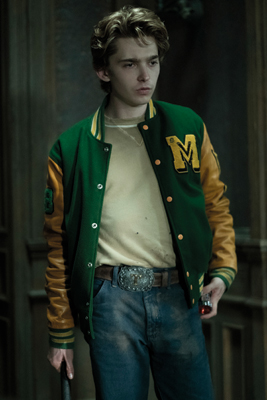 Chuck:
Chuck:
Austin Zajur takes on his first major screen role as Chuck Steinberg, the jokester of Stella's upon whom the original Scary Stories books worked their creepy magic when he was circle who helps her uncover the secrets of Sarah Bellows. Zajur is one of those kids still quite young. "Oh, those images have stuck with me my whole life so far," he muses. "And what I loved is that the script had exactly the same effect on me as the original stories, which was really cool."
He also loved having the opportunity to take on a role that has many shades to it. "There's a lot of humor to Chuck and Auggie which was great, but we also each have big character arcs and on top of that, we're put in some of the most terrifying situations you can imagine," he says. Zajur describes Chuck as "a misfit who really doesn't care what others think." "He mostly just cares about Stella and Auggie. As it turned out, we all became friends and I think the on-screen relationships in the film are a lot like our off-screen relationships."
While Zajur was excited to go back in time to 1968, he also notes that the time period reminds him in many ways of 2019 with all its divisions and anxieties. "1968 was a time when lots of things were changing and there was a lot of uncertainty for young people, which shares a lot in common with today," he says.
Of course, like the others, Zajur knew the moment would come when Chuck has to face his biggest fear, which for him, comes in the glaring white halls of an old mental asylum. "Chuck's greatest fear is being trapped and isolated where he feels like there's no escape," Zajur explains. "I think he also fears having no one believe he's telling the truth. And all of that comes out in this one very cool, very scary scene."
Ruth:
Chuck's older sister Ruth Steinberg may be the only cool kid in their midst, but Sarah Bellows does not spare her either. First, her friend Tommy, played by Austin Abrams Chuck's older sister Ruth Steinberg may be the only cool kid in their midst, but Sarah, goes missing in the fields, his clothes found on a raggedy old scarecrow.
Then, Ruth has her own hair-raising incident. Taking the role is Natalie Ganzhorn, the young Canadian who has been seen on television's Make It Pop and The Stanley Dynamic. Ganzhorn had a blast with the vivacious Ruth. "Ruth is your ultimate girly-girl," Ganzhorn describes. "She is obsessed with being perfect, always has her hair and makeup done, and always has adorable little outfits. And of course, it comes naturally that what she most fears is the thought of losing control."
That comes back to bite Ruth, quite literally, when her character encounters a spider in the Bellows mansion, which later spirals into a dizzyingly insane catastrophe. "I am personally so afraid of spiders that I knew there was going to be no acting needed for my big scene," Ganzhorn laughs. "I genuinely was terrified of what was happening to my character. Now I'm excited to see people's reactions to it. Since it was so terrifying to film, I can only imagine how terrifying it's going to be to watch."
Just the facial prosthetics alone gave Ganzhorn a jolt. "Every time I passed a mirror, I couldn't help but jump at what I saw!" she confesses.
Ganzhorn was also given the chills on set by Harold the Scarecrow, who comes for Tommy. "I expect fans of the book are going to be thrilled with how Harold comes alive. It felt to me just like the illustrations from the book were walking out of the pages," she muses.
At the same time, Ganzhorn loves that the story at the heart of Scary Stories To Tell In The Dark is about far more than the plentiful shock-scares. "I think there are some really cool themes that we see about how we treat people who are different and not stereotypically ft in"but it's all against this backdrop that you know is going to terrify."
Joining the young cast of Scary Stories To Tell in the Dark are a host of veteran stars including Lorraine Toussaint (Selma, Orange Is The New Black) as Lou Lou, the last living person who knows the Bellows family secrets; Dean Norris (Breaking Bad, Scandal) as Stella's estranged father, Gil Bellows (Patriot, Jett) as the local Police Chief and Kathleen Pollard (who was Sally Hawkins' stunt double in The Shape of Water) as Sarah Bellows.
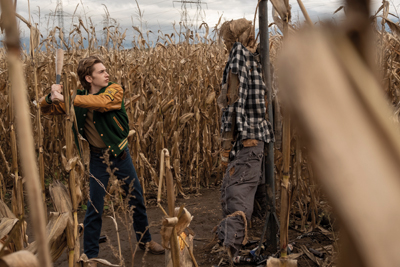 The Monster Makers At Work
The Monster Makers At Work
When the Scary Stories To Tell In The Dark books were first published what shocked and thrilled readers the most were the illustrations by Stephen Gammell. Each one seemed to nearly claw and ooze its way off the pages. There was something almost unearthly about their details, as if Gammell had actually seen, or at least dreamed, such dastardly creatures in real life and had shipped off the drawings of what he encountered before the ink could dry. From the start, Del Toro and Øvredal felt a drive to find a way to keep that feeling intact on screen.
"Guillermo was always drawn to the starkness and their drama of the drawings," notes producer Dale. "In fact, he had bought a bunch of Gammell's original illustrations years ago. Gammell himself thought there was no original artwork out there, but Guillermo said, 'Oh, I bought 10 of them years ago at a store in the New Line building.'"
Says Del Toro of Gammell's vision: "Gammell has a way of doing these almost liquid-like graphite lines. They are not just monsters, they have personality, they have intention, they have intelligence and they have tenderness."
With determination to preserve the art of practical effects to as great of a degree as possible, what all that meant to Del Toro was that he was going to need to recruit the best monster makers in Hollywood for the project. "I knew for what we wanted to create that we needed the highest grade of sculpting you can demand from an artist"the kind only a few sculptors can do," Del Toro explains. "So, we brought in the best sculptors I know in the makeup effects business. We brought in Mike Elizalde's Spectral Motion, and we had Norman Cabrera and Mike Hill each sculpt two of our main monsters. They are the top of the line. I don't know anyone better."
For Øvredal it was an intensive education in monster making. "This is my first time working with practical monsters on this level," he notes. "I was thinking initially, okay, I assume we will have to do this with digital creatures, but Guillermo convinced me very early on that no, we have to do this for real. And I was so happy about that because I saw he was committed to doing something on a very high creative level. Watching these creatures truly come alive was beautiful."
A veteran of makeup effects and creature sculpting for 3 decades, Norman Cabrera frst worked with Del Toro on Hellboy. For Scary Stories, Del Toro invited him to create two of the most iconic creatures from the collection: Harold the scarecrow and the toeless corpse.
Much as Cabrera appreciated Gammell's drawings, he knew the challenges would be huge. "The second that you attempt to turn pen-and-ink art on the page into something three-dimensional that exists in the real world, it's a whole new thing," he notes. "Suddenly, you have to look at it from all sides. Our goal was to maintain faithfulness to the art, while allowing it to live in a real space. It was difficult at times but also a tremendous amount of fun.
For Harold, Cabrera began by casting actor Mark Steger's (Stranger Things) head. "I've had a relationship with Mark playing monsters in other movies and I knew that he's an amazing performer," says Cabrera. "So, we started by making a cast of him and then we sculpted the features of Harold over his face, constantly turning it around and looking at it from every possible angle. As it came to life with Mark, it was really cool. Harold has a very extra personality."
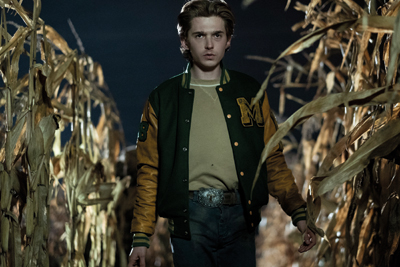 The fnal result spurred nightmares even among the crew. "He really seemed to strike a nerve," laughs Cabrera. "The first day we shot him was in the storm. The wind was whipping around Harold and it looked like he was bringing the, the cornfield to life somehow with a supernatural energy. It was very magical and very scary."
The fnal result spurred nightmares even among the crew. "He really seemed to strike a nerve," laughs Cabrera. "The first day we shot him was in the storm. The wind was whipping around Harold and it looked like he was bringing the, the cornfield to life somehow with a supernatural energy. It was very magical and very scary."
Likewise, for The Big Toe, Cabrera and team worked with Javier Botet, who portrays the skeletal toeless corpse. "Norman really followed Gammell and Gammell likes to use very intense textures and negative spaces," says Del Toro. "So, this led us to using Javier, a performer from Spain who is incredibly thin and helped us to make the corpse look like a living cadaver."
Joining with Cabrera is Mike Hill, who collaborated with Del Toro on the aquatic creature who forms the heart of The Shape of Water. For Scary Stories, he designed The Pale Lady and The Jangly Man.
Hill took his assignment extremely seriously. "People have such strong memories of being frightened by the book's illustrations, so we felt a responsibility to get that feeling back. The aim is that new audiences will love these characters and those who read the books as children feel like they're meeting old friends again," says Hill.
The Pale Lady, an unsettling vision of a woman with long black hair, a moonlight-pale face and a melancholy look gets under the skin, was a favorite. She appeared in the Schwartz book More Scary Stores To Tell In The Dark in a tale entitled The Dream. "I really strove to make her as accurate as I could to the book," Hill says. "Something about her really spoke to me. In some ways she looks like a nice older lady, but when that nice lady walks into your bedroom at night, she's not so nice anymore and the whole mood changes. I'm really proud of how much the final result reflects Gammell's artwork."
Creating the gruesome Jangly Man essentially from scratch was the icing on the cake for Hill. Though drawn from the story Me Tie Doughty Walker, in which a severed head falls down a chimney, the Jangly Man is an entire human form re-constructed from severed body parts. "He's going to be a real big eye opener for the audience because we've not seen anything quite like him in the books," Hill says. "He's the one character with a wholly original look." Hill worked closely with Troy James (recently seen as Baba Yaga in the 2019 Hellboy) who brings the character to life. "We started with a foam latex head and then we built silicon body parts in separate pieces: arms, legs, hands, chest and torso. When all these pieces come together, and he stands up, Jangly is this seven-foot-tall, terrifying creature"and I think that's going to be a real standout moment in the movie."
For Hill, working with Del Toro again was like revisiting a dream. "It's so amazing working with Guillermo because he lets you be an artist. And he brings in particular artists because he sees in them the ability to bring a specific creature to life. At the same time, you can't pull the wool over his eyes. He's your best friend but you can't cheat him because he knows as well as you do exactly how these things are made and what is needed to make them feel real."
Del Toro worked with Spectral Motion at the most detailed level to make the creatures feel one-of-a-piece with the ink illustrations, only using digital effects at the fnal stages. "One thing we did was to keep all the creatures very pale, in whites, oyster grays and yellow parchment colors, so they are all very sort of bleached out of color," he explains. "In some instances, we created a digital effect that makes things feel more liquid and not really solid. It was important to try to capture that feeling in the illustrations, because they are why the book has endured beyond just being campfire stories."
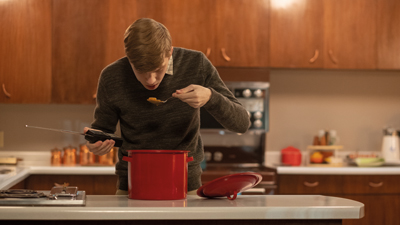 The Haunted House Of Mill Valley
The Haunted House Of Mill Valley
As production got underway, André Øvredal's enhance every jump and tingle. They include cinematographer Roman Osin, who shot Øvredal assembled a crack crew to capture and The Autopsy of John Doe, production designer Dave Brisbin (The Day The Earth Stood Still), two-time Academy Award® nominated costume designer Ruth Myers (Emma, The Addams Family, LA Confdential), editor Patrick Larsgaard (who worked with Øvredal on The Autopsy of Jane Doe and Trollhunter) and composers Marco Beltrami (a two-time Academy Award® nominee for The Hurt Locker and 3:10 to Yuma and Golden Globe® nominee for A Quiet Place) and Anna Drubich (Anna Karenina.)
Øvredal especially enjoyed reuniting with Osin. "Our tastes are very similar. We both love wide lenses and low angles. For this film we referenced lots of 1960s colors, and we looked quite a bit at William Eggleston for inspiration," says Øvredal, referring to the legendary photographer known for his use of color and his monumental takes on everyday motel rooms, roads and storefronts of the 20th Century. "We wanted everything to feel authentic to the time period but also to feel immediate and real, not like pastiche or nostalgia."
Mill Valley was created very much as an Everywhere, USA"a small town with an iconic, placid feel but its own underlying tensions if you scratch the surface… and a place which, like all American towns of every size and style, has its share of eerie local legends. In some towns, the source of those legends might be lodged in an old hospital or hotel; in others it's a farmhouse or a patch of forest. But in Mill Valley, the dark past lives on inside the decaying Bellows mansion. One of the first major triumphs of the production was unearthing a pitch-perfect stand-in for the mansion in a former Victorian oil town in Ontario, Canada. "It was our location manager who found this amazing house out in a little town called Petrolia, just outside Toronto. It stunned us," recalls Øvredal. "When we entered, the inside was as fantastical as the outside. It almost felt like the house was created to be a haunted house in a movie!"
In fact, the house was built as a home in 1890 by a family of wealthy industrialists. They commissioned the structure to echo the Richardsonian Romanesque style, the grand and imposing take on gothic architecture dreamed up by Henry Hobson Richardson. With the style's rounded towers, cone-shaped roofs, heavy masonry walls, and fortress-like feeling, it has long been a standard for haunted mansions. But in this particular house, dilapidated and long abandoned, the atmosphere was especially ripe.
The house was so intriguing that production designer Brisbin set out to re-create the interiors as more flexible sets to allow for the roaming camera Øvredal enjoys using. "The Petrolia house already reeked of wealthy industrial evil baron, which was just perfect. But then we expanded on that. We wanted to connect a sense of the mysterious and unreal to something that would feel real and grounded."
Brisbin continues: "So, we used the house as the basis for creating our own interiors. We added a long foyer from the entrance to the staircase [itself an homage to Gammell] for key scenes, as well as a library and dining room. The house had its own very spooky basement, but we then created the catacombs, which make it very chilling when you see where Sarah is being kept by her family."
In addition to the house in Petrolia, Brisbin looked to the famed Cupples House in St. Louis, a well-preserved, castle-like Richardson Romanesque mansion commissioned by the industrialist Samuel Cupples in the late 19th Century. Gothic interior touches intensified the atmosphere, right down to the wallpaper. "Wallpaper was very important in late 19th century houses," notes Brisbin. "We found a wonderful 1888 paper by the French designer C.F.A. Voysey that actually featured little devil motifs. That felt right in line with the Bellows home!"
The interiors also had to go through several iterations. "We had to age everything in the house 70 years," points out Brisbin. "What the teens originally find is a place that is desecrated, dusty and colorless. But even in the beginning of the film, for a moment only, Chuck opens an armoire and sees the 1898 pristine world that the Bellows lived in."
Throughout his sets, Brisbin sprinkled numerous Easter egg surprises for fans of the book. For the cast, the sets were exactly what they needed to set their nerves on edge. "Having the right environment was so important," says Michael Garza. "The house had to be the stepping stone to all of the madness that happens to our characters. What the team created was definitely creepy and haunting, but it was also kind of beautiful."
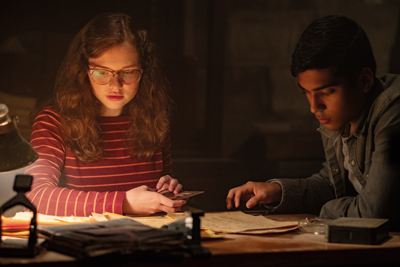 The Straitjacket That Became A Dress: The Costumes
The Straitjacket That Became A Dress: The Costumes
Haunting and beautiful was also a combination that inspired costume designer Ruth Myers. She says it was Gammell's artwork that lit her desire to work on the project. "It would be impossible to do this film without being really informed by the drawings, which are fabulous and so unique," she says. "The costumes had to add to that atmosphere."
Myers was equally drawn to working with Del Toro and Øvredal. "What I love is that with both Guillermo and André there is an atmosphere of shoot for the stars. They make you feel there's no reason not to push as far as you can," she says.
Dressing Stella, Ramon, Auggie and Chuck as typical late 60s teens, albeit misfits with their own style, became another joy. "I see them as four dreamers, dreamers who think they can move mountains," Myers describes.
She wanted them to be of their times but not in any way ironic. "What I really wanted was for them to stand out against this background of a town which is slightly in decline, but without them being mad fabulous hippies," Myers says. "Of course, 1968 was coming up to the Summer of Love and everyone was throwing out the old fashion references. Clothes were becoming more unisex. Jeans were becoming high fashion and no longer utilitarian. So, I played a bit with all that but in the manner that you would see it happening in a small town."
Most of all, Myers wanted each character's persona to shine through their clothing. "All of the actors loved their costumes and that's when you know you're doing it right," she says.
Stella, who is so unabashedly herself, was a favorite. "She has an almost natural sense of style, which is quite outside anyone else's which fits with who she is," says Myers. "There are things she wears which she's obviously done for herself. For example, she has these slightly flared trousers that are obviously homemade from a pair of straight trousers, which made me smile every time I saw it."
Ruth is Stella's fashion opposite. "Ruth is quite fashion forward, but small-town fashion forward. She favors the classic glamor of Brigitte Bardot, Marilyn Monroe or Dusty Springfeld. That's her way of standing out in the town," Myers observes.
Natalie Ganzhorn adored Ruth's look. "The outfits helped me automatically feel in character," says Ganzhorn. "From my first fitting I absolutely loved everything I tried on. There were so many pretty colors, fun poufy skirts, pink hairbows and just great stuff."
For Ramon, Myers looked to 50s and 60s teen icons. "I saw him as somewhere between James Dean and Bob Dylan, with a few other people thrown in, too," she muses. "I wanted him to feel like an idealized memory of the sexy outsider"someone slightly dangerous but charismatic who came into the town and no one knows quite what he's about."
Then there was the duo of Auggie and Chuck. "I had fun with Auggie's Pierrot," laughs Myers. "I love that he is someone who normally is seen in the most conventional clothes, but when he breaks out, he breaks out hugely into this absolutely ridiculous, amazing, very look-at-me costume. And with Chuck, we made everything mismatching. He has that teenage look that says he cares yet he doesn't care about how he looks, both at the same time."
Myers coup de grace was dressing Sarah Bellows, who is brought to eerie life by Kathleen Pollard. "I started with a palette that matched what David Brisbin was doing with the house and wallpaper," Myers explains. "For Sarah, Guillermo always said he wanted a baroque dress, but I turned that into a kind of Victorian straight-jacket. I'm very proud of that piece because it feels of its era, yet it's extremely scary, this brutal dress with its terrible chains!"
The straight-jacket gown was a knockout for Øvredal. "Ruth's design allowed us to have this amazing moment when you first see Sarah," he says. "She emerges as a dark shape in shadow. But then slowly you see that what she's wearing is not actually dress but this worn-down, complicated straight-jacket that is very ethereal. What Ruth invented is not in any of the books. It's totally original, which is something we're all excited about."
For Øvredal that was the bottom line throughout. He wanted each element of the film"from the characters to the set dressings"to hark back to the primal allure of classic scary stories, but also to feel fresh. "What I want most of all is for audiences to have a fearful but wonderful time in the theater," he concludes. "Of course, I want people to get some shocks, but also to come away with a sense of adventure they weren't expecting from a horror story."
In the final minutes of Scary Stories To Tell In The Dark it becomes clear that for all that Stella has lost and learned amid the unsettling events in Mill Valley, there is more for her to uncover and more tales for her to tell. Concludes Natalie Ganzhorn: "The door is left open for more stories, and that makes sense because the fascination for scary stories never gets old."
Release Date: September 26th, 2019
MORE


